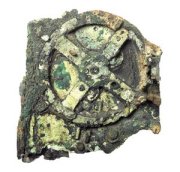
Everyone who comes across the Antikythera mechanism goes through an initial phase of disbelief, then the awe-inspiring realisation that something almost from another world actually exists in ours.
Imagine William Shakespeare writing Hamlet using a laptop. Surely a ridiculous proposition, he was about 300 years too early for that. He didn’t but today’s topic is just as incredible but thanks to the presence of physical evidence- true.
The bronze department of the Museum in Athens has a small device slightly bigger than a pocket dictionary which has spent 2000 years under the Mediterranean Sea. It’s a handmade, hand-operated mechanical mechanism which may have looked like a multi-handed clock. This remarkably compact device can display the calendar, predict eclipses, illustrate the phase of the moon, indicate the position of most of the planets and even takes account of the precession of the lunar orbit. The mechanism is driven by a collection of precision gear wheels made in Greece about 100 BC and nothing like it would be made again for at least another 1000 years.
My thanks to members of the Manchester Astronomical Society who arranged this visit for Tony Freeth to come and talk to them, and Conway Mothobi of the Manchester Metropolitan University hosting the event where this recording was made.My thanks, of course, to Tony Freeth for making the time on the day.
Other videos on Youtube
-
- Michael Wrights’ working model
- An excellent version of the Antikythera Mechanism made with Lego.
Podcast: Play in new window | Download (Duration: 25:37 — 23.4MB) | Embed
Subscribe: Apple Podcasts | Spotify | RSS | More